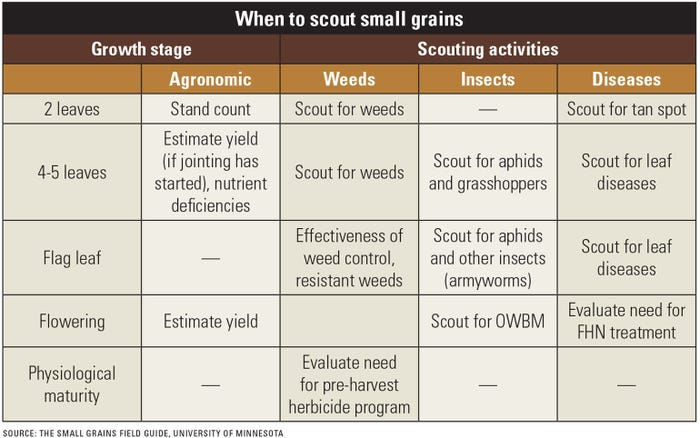
If you’re a small grains farmer, plan on doing more of your own scouting this growing season.
Jochum Wiersma, University of Minnesota Extension small grains specialist at the Northwest Research and Outreach Center in Crookston, shared in a recent crop news blog that the COVID-19 pandemic has temporarily changed how Extension will gather crop information this season.
“This year there are no scouts trekking across the state to determine the presence of disease and pest problems in fields,” Wiersma said. “Instead, I'll rely on colleagues, cooperators and crop consultants to share observations.”
Wiersma usually depends on three scouts in west-central and northwestern Minnesota who focus on walking through fields of hard red spring wheat and sending reports back to him.
Without their reports, small grains farmers will have a less complete picture of what is happening in an area, thereby informing them of what they should be looking for in their own fields, he said.
This growing season, Wiersma encouraged farmers to walk their own fields, and often.
“Take time to do it thoroughly and not scout just the headland,” he said.
The U-M Extension book, “The Small Grains Field Guide,” co-authored by Wiersma, offers more detail on how to do an effective job at scouting. Here are a few tips he shared in the publication:
Scout regularly. Frequency of sampling depends on the pest threat. Ideally, do it weekly. If weather is cooler, lengthen the sample time period. If temps are higher, shorten them.
Develop fast, simple scouting methods. There are six major periods for scouting small grain fields (see table). Yes, scouting takes time. To do it properly, plan on about an hour for every 80 acres and do it strategically. When you can, look for weeds, insects and diseases at the same time to reduce overall scouting time. Note that there are certain small grain pests that are linked to time sensitive treatments or must be scouted for under specific conditions, such as orange wheat blossom midge or aphids.
 WHEN, WHAT: This when-to-scout guide for small grains offers a timeline for when growers should be looking for pests and diseases.
WHEN, WHAT: This when-to-scout guide for small grains offers a timeline for when growers should be looking for pests and diseases.

Take a sufficient number of samples to accurately reflect the population of the pest within the field. When sampling for aphids in small grains, for example, approximately 100 samples should accurately reflect the entire field population.
For other insects, such as grasshoppers, populations are often concentrated on the edges of fields and sampling efforts should first be concentrated there.
Scouting location and pattern will depend on field distribution of the pest monitored and field size and shape. If the pest is evenly distributed throughout the entire field, such as aphids, root maggots, and most armyworms, walking in specific patterns, such as circular, a "W" or a "Z", help ensure that the entire insect population would have the opportunity to be sampled.
Some pests are associated with field conditions, such as low or high elevation, wet or dry organic content, or low or high organic content. Sampling efforts would then be concentrated in those areas.
Some insects, like grasshoppers, generally concentrate on the field edges, but also may get into the field. Scouting field margins first will provide a good indication whether sampling within the field is required.
Keep scouting supplies ready to go. A pocketknife, a hand lens and reference materials are essential in the field. A good sweep net is handy when scouting for insects. A standard sweep net has a 15-inch opening.
Keep good notes. Record-keeping is key. Data sheets should contain all information that will be needed to later make management decisions. If cost-benefit decision equations are available for the crop and pest, the formula should be included on the sheet. Don’t forget to record the location. Historic patterns of pest infestation may help concentrate future sampling efforts in those locations where infestation is heaviest.
Save specimens. Clear plastic zip-lock bags or screw-top vials, alcohol and forceps or tweezers are useful for collecting insects for later identification. You could also build your own reference collection to make future identifications much easier.
About the Author(s)
You May Also Like






